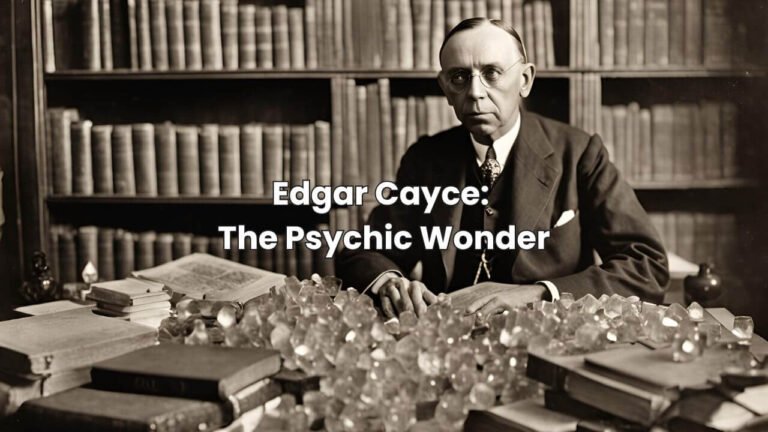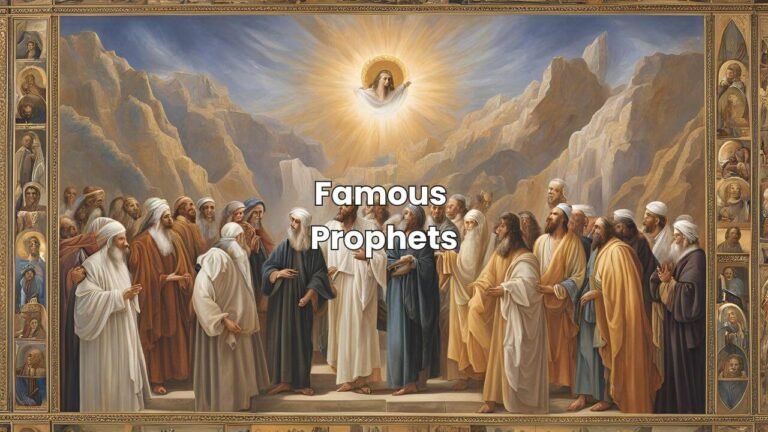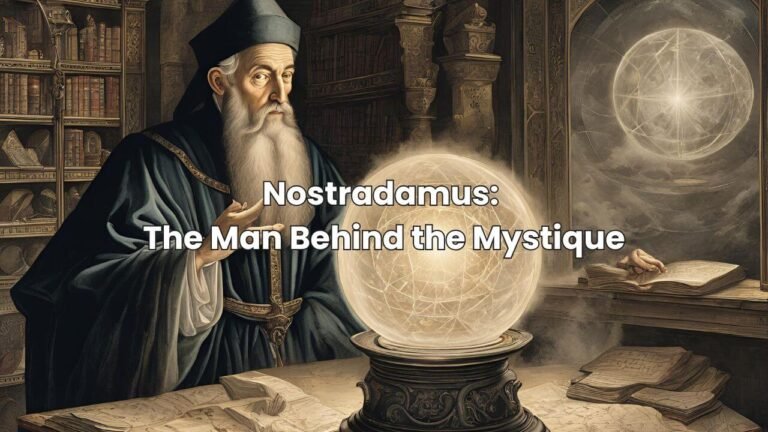
Born on 14th December 1503 in Saint-Remy-de-Provence, South France, Michel de Nostradame was destined to emerge as one of history’s most enigmatic and famed figures – Nostradamus. Descended from Jewish lineage, his family had converted to Christianity due to anti-semitic pressure, shaping the early life of Nostradamus with a melange of diverse religious and cultural influences.
Nostradamus was tutored by his maternal grandmother who imparted knowledge in classical languages, mathematics, astronomy, and astrology; all of which set the groundwork for his later prophecies. Tragically, the plague claimed his parents when he was just a teenager, plunging young Nostradamus into a world of uncertainty and survival. Nevertheless, these adversities did not deter him, instead, they propelled the headstrong teenager to embark on his journey towards becoming the world’s most renowned seer.
Academic Pursuits and Influences in Nostradamus’s Early Years
In the early years of Michel de Nostredame, more commonly known as Nostradamus, academia played a significant role in shaping his life and works. He began his scholarly endeavours at Avignon, learning the traditional subjects of Latin, Greek, Hebrew, and mathematics. Until he was expelled during an outbreak of the Plague, Nostradamus studied a wide variety of humanities. But his interests and studies were not confined to natural sciences and humanities alone. He also delved deeply into astrology, a practice that would significantly influence his later life, offering a philosophical backdrop to many of his illustrious prophecies.
The late life of Nostradamus was marked by a more profound dedication to his astrological studies and the writing of predictions. His academic pursuits in his early years provided him a solid grounding in various disciplines, which cast a deep influence over his late-life works. His predictions were enunciated in his masterpiece, The Prophecies, where he brought together his knowledge of astrology, medicine, and prophecy. He integrated his academic knowledge with a deep intuition, resulting in some of the most enduring and controversial predictions in history.
The Transition: Key Events in Nostradamus’s Late Life
Late in life, a curious turn of events inspired Nostradamus’s transformation from a renowned doctor to the acclaimed seer we recognize him as today. This juncture was galvanized by his move to Salon-de-Provence after the loss of his first wife and children to an unknown disease which his medical expertise couldn’t combat. This loss marked the cessation of his medical practice and triggered his life’s most profound transition.
In Salon-de-Provence, he commenced the unique practice of water gazing that lead him to his divinations. He penned his prophecies in quatrains which turned him into a visionary exploring beyond his time. One particular prophecy that has intrigued researchers to the day revolves around Nostradamus and World Wars predictions. His enigmatic writings, interpreted as foretelling the advent of both World Wars, have stirred historians and conspiracy theorists alike, marking these late-life years as some of the most pivotal in Nostradamus’s timeline.
Nostradamus’s Vision of Conflict: World Wars Predictions
Delving into the all prophecies of Nostradamus reveals a jarring foresight of major global conflicts, most notably what are now recognized as the two World Wars. Many believe that his ability to foresee the future stemmed from his mastery in astrology and his profound insight into the human condition. In his Quatrains, he wrote certain verses that have since been interpreted as predicting Adolf Hitler’s rise, the nuclear bombings in Hiroshima and Nagasaki, and numerous other fatal conflicts of the 20th century.
His cryptic verses are loaded with analogies and symbolic language, making them subject to various interpretations. The predictions were constituted in a mix of French, Greek, Latin, and some made-up words which lends further mystery to his prophecies. Despite the complexity and enigmatic nature of his writings, scholars have deciphered and found uncanny resemblances between Nostradamus’s quatrains and the sequence of the world wars. His intrigue and relevance persist even in contemporary times given his track record of accurate prophecies.
Comprehensive Insights into the Prophecies of Nostradamus
An essential cornerstone of understanding Nostradamus’ prophecies lies in decoding the content of the best Nostradamus book. Commonly regarded as his magnum opus, “Les Propheties”, this work encapsulates a host of cryptic predictions, meticulously penned down in the form of quatrains. These cryptic prophecies span across a plethora of topics such as natural disasters, global conflicts, scientific advancements, and societal transformations.
The best Nostradamus book is a remarkable testament to the seer’s profound foresight and unparalleled psychic ability. Readers often marvel at the complexity and coherence of the writings. They span visionary glimpses into centuries beyond Nostradamus’s lifetime. The text, despite its inherent ambiguity and metaphorical complexity, has gripped scholars, researchers, and curious minds for centuries. Each prophecy continues to stand as a metaphoric riddle, reigniting avid debates about what future might unfurl.
Decoding the Best Nostradamus Book: An Exploration
Among the numerous chronicles of the French seer, Nostradamis, one tome stands above the rest in terms of details, accuracy and far-reaching interpretation of the psychic’s prophecies – Les Propheties. This book, first published in 1555, contains 942 poetic quatrains that allegedly predict future events. It brought to light many of the Nostradamus predictions that are believed to have come true in the following centuries, from the rise of Napoleon and Hitler to the devastating fires of great London.
Diving deep into the content of Les Propheties, readers find it to be an ocean of metaphors, symbolism, and a uniquely layered structure that demands profound examination and knowledge of historical contexts to extract the hidden meanings. Thus, decoding this ‘best’ among Nostradamus’s book has been both a challenge and fascination for scholars and enthusiasts for centuries. Its intriguing narrative structure and prophetic content, especially in light of the Nostradamus predictions that came true, continue to engage people in a timeless quest for understanding the future through the past.
To further understand the significance and depth of Les Propheties, it’s crucial to highlight its key features:
- The book is composed of 942 quatrains – four-line poetic verses. Each quatrain allegedly contains a prophecy about future events.
- Nostradamus used a mixture of French, Greek, Latin and Occitan languages in his quatrains. This linguistic diversity adds another layer to the complexity of decoding the prophecies.
- He employed various forms of wordplay and allusion in his writings. These include anagrams, homophones, classical mythology references and astrological symbolism.
Many believe that some predictions from Les Propheties have already come true. For instance:
- Napoleon Bonaparte’s rise to power
- Adolf Hitler’s dictatorship
- The Great Fire of London
Understanding these aspects can provide readers with a new perspective on this remarkable work by Nostradamus:
- It requires deep knowledge about history: Since many prophecies are believed to be cloaked under historical events or figures’ names, understanding them necessitates extensive historical knowledge.
- It demands proficiency in multiple languages: To decipher the meaning behind each quatrain accurately, one needs proficiency not just in French but also Greek, Latin and Occitan.
- Interpretation varies among scholars: Different researchers might interpret the same quatrain differently based on their understanding or perspective. Hence there’s no universally accepted interpretation for any given prediction.
The allure surrounding Les Propheties continues unabated as people strive to decode its hidden meanings hoping they might shed light on future events yet unknown or unimagined.
Evidence of Foresight: Nostradamus Predictions that Materialized
Nostradamus, the 16th-century apothecary and seer, gained notoriety for his cryptic, yet intriguing quatrains that have been interpreted by many as prophetic. Among his most famous writings are predictions that have since materialized, providing evidence of his uncanny foresight. His enigmatic verses have been dissected, analyzed and reinterpreted over centuries, and surprisingly, some have seemingly corresponded to actual historical events.
Interestingly, even the End Time Prophecies by Nostradamus share certain parallels with events that later transpired. Scholars, for instance, have pointed out correlations between his writings and the 1666 Great Fire of London. Despite the quatrains’ nature of being open to wide interpretations, debatable deciphering, and the issues of hindsight bias, the potency of Nostradamus’s writings remains unquestionable. Such manifest predictions continue to feed the global curiosity regarding Nostradamus’s prophecies, further testament to his perpetual enigma.
Apocalyptic Visions: End Time Prophecies by Nostradamus
Nostradamus, a seer of the Renaissance period, has for centuries garnered fascination and intrigue for his cryptic, apocalyptic predictions. Renowned for his collection of prophecies, Les Prophéties, which consisted of rhymed quatrains grouped into nine sets of 100 and one of 42, collectively referred to as “Centuries” – his end time prophecies were, and remain, the subject of intense debate. He is believed to possess a special gift of seeing into future, divulging into cataclysmic events, from fiery heavens to floods, famines, and wars, his predictions were dire and shrouded in darkness, painting a grim picture of the world’s end time.
Particularly, his infamous prophecy about the “great calamity,” believed to predict an asteroid hitting the earth, sent chills down the spines of many. His quatrains often referenced celestial configurations or events, and over the centuries, many convincingly argued that Nostradamus foresaw major global catastrophes. The legitimacy of these claims does vary vastly among scholars, critics, and ardent followers of his work. While some insist that his end time predictions are a bleak insight into humanity’s future, others contend these prophecies to be ambiguous verses liable to myriad interpretations. Thus, the apocalyptic visions of Nostradamus occupy a riveting ambivalence in the annals of prophetic literature.
Legacy of Nostradamus: The Impact and Continued Relevance
The far-reaching effect of Nostradamus’s writings cannot be overstated. His enigmatic quatrains have continued to intrigue scholars and the general public alike, centuries after his death. The astoundingly accurate predictions, penned in cryptic verses, have only fuelled this undying fascination. Even in the ever-advancing age of science and reason, Nostradamus’s prophecies hold a special place in popular culture, suggesting an inherent human propensity towards mysticism and the unknown.
Nostradamus’s legacy also spans beyond the realm of predictions, uncannily touching upon anthropology, history, and spirituality. His works offer unique insights into 16th century Europe, acting as historical documents as much as they do prognostications. Furthermore, the continued relevance of his prophecies is underscored by the surge of interest during times of global crises. Despite skeptics dismissing his predictions as vague and open to interpretation, the enigma of Nostradamus persists, reminding us of the timeless allure of the mysterious and the unexplained.
Reflections on Nostradamus: A Retrospective Analysis
Nostradamus, born Michel de Nostredame, remains one of history’s most intriguing and enigmatic figures. His prominence as a reputed seer, credited with numerous predictions of major world events, still resonates today. Deeply rooted in the 16th century, his work resonates with people centuries later- a testament to his enduring relevance and the human fascination with prophetic abilities.
A comprehensive retrospective analysis of Nostradamus offers a complex view of this historical figure. To some, he stands as a figure of profound wisdom whose predictions bear uncanny accuracy and profundity; to others, he is seen as a vague and ambiguous figure whose quatrains are interpreted liberally to fit a wide array of world events. Regardless of differing perceptions, Nostradamus continues to capture the collective imagination, stimulating lively discourse and insatiable curiosity even today.
Who was Nostradamus?
Nostradamus was a 16th century French astrologer, physician, and reputed seer. He is best known for his book, ‘Les Prophéties’, which is a compilation of 942 poetic quatrains allegedly predicting future events.
What was the early life of Nostradamus like?
Nostradamus was born in the early 16th century in France. His early years were marked by a thirst for knowledge, with him delving into various academic pursuits and being influenced by a variety of scholarly figures of his time.
What were some key events in Nostradamus’s later life?
The later years of Nostradamus’s life were marked by a transition from a medical career to prophecy and astrology. He began publishing collections of prophecies, each containing hundred quatrains, predicting undefined and vague future events.
Did Nostradamus predict the World Wars?
Many believe that Nostradamus prophesied the occurrence of both World Wars in his quatrains. However, the interpretations of his writings are subject to debate due to their cryptic and vague nature.
Can you provide some insights into Nostradamus’s prophecies?
Nostradamus’s prophecies were written in a cryptic language with a mixture of Latin, French and Greek, and often used symbolism. They have been interpreted and analyzed in various ways over the centuries.
What is the best book to understand Nostradamus’s prophecies?
Nostradamus’s own book, ‘Les Prophéties’, is a primary source. But, there are also many other books written by scholars that aim to decode and interpret his prophecies.
What are some of Nostradamus’s predictions that came true?
Some argue that Nostradamus predicted events like the French Revolution, the rise of Adolf Hitler, and even the 9/11 attacks in the United States. However, these interpretations are often debated for their accuracy.
Did Nostradamus make any end of time prophecies?
Yes, Nostradamus is known to have made several prophecies about what he termed as the ‘end times‘. However, these prophecies are often interpreted in different ways by scholars.
What is Nostradamus’s legacy?
The legacy of Nostradamus extends far beyond his lifetime. His prophecies continue to be studied, interpreted, and debated, and he remains one of the most famous figures in the realm of prophecy and foresight.
What is the purpose of this retrospective analysis on Nostradamus?
The purpose of this retrospective analysis on Nostradamus is to provide a comprehensive understanding of his life, works, prophecies, and their continued relevance in the modern world.





dmf ZwG vVq dzSCfPFa
Reading this felt like finding a long-lost treasure — a piece of writing that enlightens and comforts in equal measure.
Ставки небольшие, но эмоции как будто поставил всё. Всё изменилось после того, как нашёл Vodka Casino для Android. Игры продуманы до деталей. Бонусы не просто на словах — они реально работают. Промокоды придают игре вкус. Интерфейс не важен, если внутри огонь. Такие впечатления редко где получишь.
Играю давно, повидал многое, но в последний месяц завис именно на этой платформе. Причина банальна: всё работает и даёт результат. Когда я решил Vodka Casino установить, не ожидал, что получу настолько стабильную и живую игру. Тут нет ощущения, что играешь в демо-режим — каждая ставка, каждый раунд ощущается как настоящая битва. Особенно радует система кэшбэка — даже если не повезло, знаешь, что часть вернётся. Есть ощущение заботы: техподдержка реагирует быстро, акции подбираются под твою активность, интерфейс не раздражает. Это не просто казино, а платформа, где чувствуешь себя частью игры. А ещё тут реально выигрывают, и это видно по постоянным обновлениям ленты победителей.
888starz поддержка https://www.covrik.com/covers/inc/888starz-app-mobile-android-ios.html
888starz автоматы http://travel-siberia.ru/uploads/articles/onlayn-kazino-dlya-ios-kakie-prilozgheniya-samue-udobnue.html
BrunoCasino reload bonus https://mathedu.hbcse.tifr.res.in/forums/topic/top-air-hostess-best-institute-in-lucknow-2024/#post-207963;https://mathedu.hbcse.tifr.res.in/forums/topic/is-it-worth-switching-to-a-crypto-card-for-online-shopping-2/#post-207964
888starz скачать зеркало http://1by.by/stat/stoit-li-igrat-s-telefona-preimushhestva-i-nedostatki.html
canadian online pokies that accept paypal, casino united
kingdom bonus sans depot and 200 free spins no deposit canada, or best payout online slots australia
Also visit my homepage :: most common Winning Roulette numbers
Aby się zarejestrować, należy: Podać numer telefonu lub adres e-mail Ustawić hasło do konta Wybrać walutę głównego salda Kliknąć „Zarejestruj się” Przed zakończeniem rejestracji musisz zaakceptować regulamin kasyna.
quatro casino canada, online gambling blackjack – Rosaria, ads uk and casino online australia
free, or play slots online for real united states
888 starz https://www.pgyer.com/apk/apk/app.starz.online
download 888starz on Android for free https://www.pgyer.com/apk/en/apk/app.starz.online
888 starz https://www.pgyer.com/apk/fr/apk/app.starz.online